 (Warning: discussion of fictional sexual violence ahead.)
(Warning: discussion of fictional sexual violence ahead.)
It’s that time again. The time when the internet rings with screams of people crying ‘censorship’ over a pulled comic book cover that showcased the victimization of a beloved super-heroine for literally no good reason.
This week saw another comic book cover controversy spin up over a variant cover designed for DC Comics’ Batgirl #41. The cover by renowned comic artist Rafael Abuquerque (of Mondo Urbano and American Vampire fame) depicts the Joker and Batgirl in a creeper-victim pose reminiscent of the 1988 one-shot Batman story called The Killing Joke by Alan Moore. The comic is part of a promotional event going on during the month of June, where variant covers depicting the Joker would appear across DC comic lines. The event is similar to their ‘classic movie poster’ event that went on recently… except this event showcased a comic moment that still haunts Batgirl’s history to this day.
Hailed as one of the definitive Batman and Joker stories ever written, the comic became a pivotal moment for Barbara Gordon aka Batgirl when the Joker shoots her in an attempt to drive her father Commissioner Gordon insane. Barbara Gordon suffers spinal damage and ends up in a wheelchair, but perseveres and continues her crime-fighting career as Oracle, and later upon recovery of the use of her legs as Batgirl once again. Yet a more disturbing element always haunted the Killing Joke, and that’s the implied sexual violence that Barbara Gordon received at the hands of the Joker. Commissioner Gordon is stripped and tied to a chair and forced to look at photos of his daughter, naked, screaming in pain, photos that imply sexual violence. While many have said it’s unclear if rape was involved, later released edited pages by artist Brian Bolland show an even further sexualized Barbara, taking away much of the ‘implied’ nature of the violence she sustained. (Images of that redacted art under this link – warning: NSFW and TRIGGERING for sexual violence).
Many criticized the events of the Killing Joke and the violence done to Barbara Gordon as one step too far. Even Alan Moore was later interviewed and said he regretted going that far with the storyline. This is quoted directly from the wikipedia entry about the comic:
While the quote is disturbing, it is sadly unsurprising. Though comic book fans have called out victimization of women characters for years, it’s only in recent days when those call-outs seem to be making much traction. DC Comics is, in fact, the origin of the term ‘women in refrigerators’, so named for the time in Green Lantern comics that Kyle Raynor’s girlfriend was murdered, chopped up, and stuffed in his fridge all for an emotional plot-point for Kyle. So when a comic cover like this hit the internet, it received a lot of friction very fast.
The issue 41 cover is no question a throw-back cover to the Killing Joke days. The Joker is dressed much as he was in that comic, with his hands all over Batgirl as she stares at the reader with tears in her eyes. In an homage to the ‘why so serious?’ of the Batman movie series, the Joker paints a ragged smile across Barbara’s terrified face, a gun hanging loosely in his hand as he drapes his arms over her. The cover is uncomfortable, victimizing and vulnerable, and nowhere near the kick-ass, positive Batgirl we’d come to see in the previously established run of Batgirl. In fact, Cameron Stewart and the recent Batgirl team have received positive press for their reimagination of Batgirl’s costume and her new story lines. Their helming of Batgirl has brought in more readers, including and especially a younger demographic of girls that seem to enjoy Batgirl’s new style. The art in the book has reflected that shift, including and especially in their covers. Here are some examples, including one by Rafael Abuquerque (who made the above Killing Joke variant) for the upcoming Batgirl: Endgame #1:
These covers showcase Batgirl as an ass-kicking fun super heroine, fully in charge of her own story and her choices. When shown in contrast with this:
…it’s no surprise that fans went bananas.
So it’s to the credit of the Batgirl creative team that the decision was made so quickly to pull the variant cover. Writer and artist Cameron Stewart responded on Twitter, saying:
https://twitter.com/cameronMstewart/status/577639370502574081
https://twitter.com/cameronMstewart/status/577639515227078657
https://twitter.com/cameronMstewart/status/577639735788711936
https://twitter.com/cameronMstewart/status/577640016245075968
https://twitter.com/cameronMstewart/status/577640395980607488
For this sensitivity from both Abuquerque and Stewart, Stewart was besieged on Twitter by people berating him for ‘caving into censorship’ even after Stewart pointed out that Abuquerque pulled the piece himself of his own free will. The situation further escalated when DC Comics made a statement saying that those who spoke out about the comic cover were harassed. Stewart added:
https://twitter.com/cameronMstewart/status/577656291839119362
So to be clear: the people who stood up and said that the cover should be pulled, not the artist, were the ones threatened. Because that’s the world we live in now: where when people bring up objections to the further exploitation of the image of victimized women, THEY get harassed and told they’re supporting the bad kind of censorship. Even after the artist pulls down the piece of his own accord, and the creative team on the book calls for it to be pulled down themselves.
And that’s where I began to feel something like this:
I got into several discussions about the cover and the decision for its removal, and received mostly positive responses. Yet a theme sliding around on Twitter and Facebook that disturbed me was the always-present comments of: I hate political correctness! It’s censoring art! A favorite of mine (name not shared for obvious reasons) was, “We give too much power to people like this [ie: those that complain] when we give in to their complaints. Everything is a potential trigger.”
And sadly, all I hear is “I don’t see why you’re so upset, I want what I want, blah blah censorship.”
First: WE didn’t give anything. The creative team behind the comic made a creative decision that they stand behind of their own free will. They had the same sense that plenty of other people had and said no to a poor artistic choice. The artist himself made that choice. You, the armchair quarterback of comic book art, had nothing to do with it.
Second: People like this is such an infuriating term. Do you mean people who spoke up about yet another example of a popular woman character being depicted in a victimized way on the cover of her own book? Of the returned reference to her sexualization and victimization in an old comic that the writer of said comic even openly admits regretting? If by ‘people like this’ you mean folks who are tired of seeing constant depictions of women characters as disempowered victims in comics for the sake of selling books, for the sake of getting attention, then yes. There are people like this out there. They’re called fans, tired of seeing their favorite women super heroes treated like damsels in distress.
I posit a test that is upsetting to me to even posit. Consider a variant comic book cover. Superman is behind held by Lex Luthor. He stares pleadingly at the reader from the pages of the cover, tears streaming down his cheeks. Luthor stares out, a creepy, proprietary smile on his lips as he puts one arm over Superman’s shoulder and dangles a hand right over Superman’s chest with a Kryptonite ring on. With the other hand, he strokes his finger over Superman’s cheeks. Creeped out yet? Kind of uncomfortable? Yeah, that’s kind of the point. Maybe now you’re getting it. And even that example isn’t a good analogy because most readers will probably fall back on a hetero-normative view of those characters, in which Superman wouldn’t be in danger of sexual violence from Luthor. But in this cover, the history of the Killing Joke that is being called up by the costume and the set-up of the piece of art clearly points directly to the previous history of sexual violence and the sexualized danger to Batgirl. The piece of art posed Batgirl with her attacker.
Do you get it yet? Do you see why this is a problem?
If not, I don’t know quite what to say to you. How to convince you that harkening back to a history of sexual violence on the cover of a comic whose audience includes kids is uncomfortable and unnecessary. How there are a million other ways to depict characters like the Joker and Batgirl that are not victimizing to the main character of her own book. How the cover is only a variant and therefore not really there to impact the story or the book run, but only to appeal to collectors as part of a marketing stunt, and how that fact makes the problem even worse. But more than that, I cannot figure out how to say to people who don’t see the problems here: just because you can do something for art doesn’t mean that it’s a good decision, in good taste, or that you should in the first place. Yes, art is free, but art without common sense and decency and thought about your audience is just a whole lot of mess. And maybe the place for a piece of art depicting a terrorized sexual violence victim is not on the place of a widely read comic book for kids and adults.
I fully support this cover being pulled, and give a well done to Rafael Abuquerque for seeing the problem and responding so graciously. I give a hearty thank you to Cameron Stewart for having the vision to call for the removal of the cover, and for his understanding as to why it was a problem.
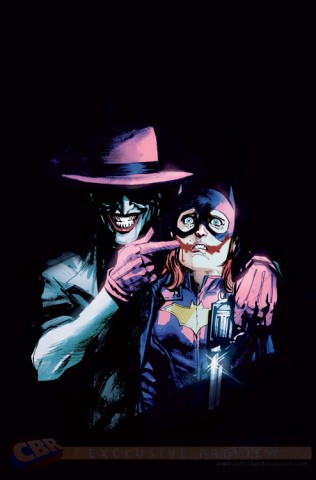
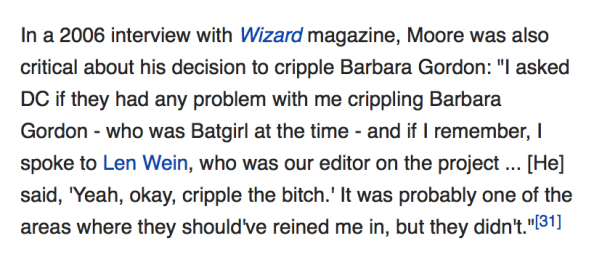

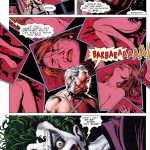
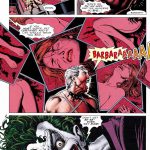

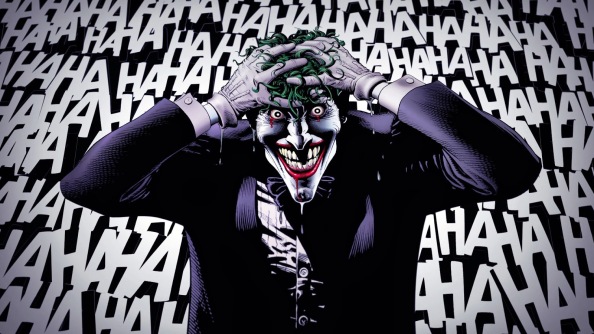
Hi
Two contradictory things to say here.
First, I agree that the pulled cover should not be on an issue of the current run of Batgirl. Batgirl is currently fun, a bit light and – if not all ages appropriate – appropriate for younger readers. That cover is just not right for that book.
However, i have no problem with that cover in and of itself. Yes, its is creepy, threatening, sexualized and horrifying… but I believe that there is room for a “NC 17” version of the Batman universe where the Joker is the most terrifying serial killer in existence. I also believe there should exist a “PG 13” Batman universe where he drives fast cars and kung fu fights costumed villains, and a “animated universe” Batman and fun, violence-light adventures.
Understood that my position is filtered through my life and position, white male privilege etc…
Hope my partial agreement and additional thoughts do not offend.
Steve W
I’ve been quite impressed with the light-hearted, retro-BG found in Batman ’66 but I might need to check out this 21st century update.
Er….That cover is a reference to killing joke and the torture of her father….. It’s joker trying to get her to snap. Joker is a killer psycho this is showing his twisted mind and what he’d do just to make you break. the cover is part of a final arc for joker (he is going to die for a while) showing that just because batgirl is back and is fun what joker did by taking her ability to walk away is still within her mind creating a sense of terror and fear.